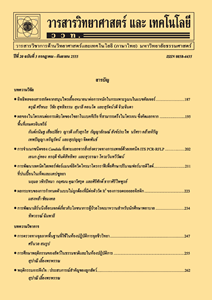การจำแนกราด้วยวิธีไอทีเอสพีซีอาร์และความสามารถในการบำบัดสีรีแอคทีฟ RR141
Main Article Content
Abstract
บทคัดย่อ
สีย้อมกลุ่มรีแอคทีฟนิยมใช้ในกระบวนการผลิตของอุตสาหกรรมสิ่งทอ แต่สีย้อมเหล่านี้สามารถละลายน้ำและมีโครงสร้างทนต่อการย่อยสลายทางชีวภาพ ทำให้ตกค้างในสิ่งแวดล้อมและก่อให้เกิดผลกระทบต่อระบบนิเวศ ซึ่งวิธีการบำบัดทางชีวภาพที่เลือกมาใช้ คือ การใช้ราที่สามารถย่อยสลายสารประกอบเชิงซ้อนและสีย้อมได้ การศึกษาครั้งนี้จึงเป็นการคัดเลือกราจากดินและเห็ดที่มีประสิทธิภาพในการบำบัดสี reactive 141 (RR141) ผลการคัดเลือกเบื้องต้นในอาหารเลี้ยงเชื้อชนิดแข็ง พบราที่สามารถบำบัดสี RR141 ที่ความเข้มข้น 50 มิลลิกรัมต่อลิตร มี 14 ไอโซเลต เมื่อนำไปทดสอบประสิทธิภาพการบำบัดสี RR141 ในอาหารเหลวที่ ความเข้มข้น 50 มิลลิกรัมต่อลิตร พบรา AP6, AP8 และ BP1 เป็นกลุ่มที่มีความสามารถในการบำบัดสี RR141 ได้สูงสุดเท่ากับ 100, 100 และ 98.97 เปอร์เซ็นต์ และมีอัตราการบำบัดสีเฉลี่ยเท่ากับ 297.62, 297.62 และ 294.55 มิลลิกรัมต่อลิตรต่อชั่วโมง ตามลำดับ ในระยะเวลา 7 วัน โดยรา AP8 แสดงประสิทธิภาพการบำบัดสูงสุดสามารถบำบัดสี RR141 ความเข้มข้น 50 และ 75 มิลลิกรัมต่อลิตรได้ 100 เปอร์เซ็นต์ ในระยะเวลา 4 วัน เมื่อระบุชนิดราทั้ง 3 ไอโซเลต ด้วยวิธีไอทีเอสพีซีอาร์ พบว่าราที่คัดแยกได้ คือ Aspergillus awamori (AP6, 97 % identity), Lentinus tigrinus (AP8, 98 % identity) และ Gongronella butleri (BP1, 95 % identity)
คำสำคัญ : ราบำบัดสี; สีรีแอคทีฟ; อุตสาหกรรมสิ่งทอ; การจำแนก; ไอทีเอสพีซีอาร์
Abstract
Reactive dyes are widely used in production process of textile industries. But these dyes dissolve well in water, resistant to biodegradation, and persist in the environment. Biodegradable fungi were selected to be biotechnological treatment for various complex compounds, including synthetic reactive dyes. This study focused on screening and identification potent soil fungi and mushrooms that were able to decolorize reactive dyes. The primary screening in agar plate showed that 14 isolates of fungi were able to decolorize reactive red 141 (RR141) at a concentration of 50 mg/L. The efficiency isolate AP6, AP8 and BP1 were investigated decolorization of 50 mg/L of reactive red in potato dextrose broth. Maximum decolorizations of three isolates were 100, 100 and 98.97% and average decolorization rates were 297.62, 297.62 and 294.55 mgL-1/h., respectively. They were achieved on a week. AP8 had shown the most efficient for decolorization. The optimum values of initial dye concentration were found 50 and 75 mg/L for 100 % decolorization on 4 days. Three isolates were identified by ITS-PCR method showed that these fungi were Aspergillus awamori (AP6, 97 % identity), Lentinus tigrinus (AP8, 96 % identity) and Gongronella butleri (BP1, 96 % identity).
Keywords: decolorization fungi; reactive dye; textile industry; identification; ITS-PCR


